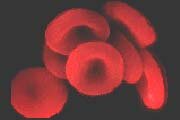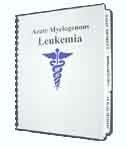 |
||
| HOME | ||
 |
||
| Acute Myelogenous Leukemia (AML) |
||
 |
||
| Other Leukemia Types (ALL / CLL / CML / HCL) |
||
 |
||
| Myelodysplastic Syndrome | ||
 |
||
| Symptoms and Diagnosis | ||
 |
||
| Leukemia Treatment Options | ||
 |
||
| " Chemotherapy | ||
 |
||
| " Blood Stem Cell Transplants | ||
 |
||
| " Radiation and Surgery | ||
 |
||
| " Chemo Side Effects | ||
 |
||
| " Clinical Trials Info | ||
 |
||
| " Coping with Leukemia | ||
 |
||
| " What to Ask Your Doctor | ||
 |
||
| Financial Assistance | ||
 |
||
| At Risk Jobs/Exposure | ||
 |
||
| Leukemia Resources | ||
 |
||
| Survivor's Story | ||
 |
||
| Leukemia News | ||
 |
||
|
Search for information:
|
||

|
Leukemia Cancer News - Return to Menu Internet Patient Recruitment Yields MPD Breakthrough By Kevin Davies (03/24/05)Using an unusual Internet recruitment strategy that found hundreds of volunteers with myeloproliferative diseases (MPDs), researchers at the Brigham and Womens Hospital in Boston have discovered mutations in a single gene that are responsible for three forms of these diseases. The MPDs in question are polycythemia vera (PV), essential thrombocythemia (ET) and myeloid metaplasia with myelofibrosis (MMM), which together affect some 100,000 Americans. The discovery, which is published online by the journal Cancer Cell, was led by D. Gary Gilliland, who is also an investigator with the Howard Hughes Medical Institute, and colleagues. The idea was to screen MPD patients for mutations in genes that code for tyrosine kinases, key enzymes that have been implicated in many other forms of cancer. In order to find sufficient numbers of patients to conduct the study, Gillilands team sought help from an advocacy group for patients with myeloproliferative disease called MPDInfo. Posting a note on the groups website, they were swamped with more than 600 responses within a matter of weeks. There was a huge outpouring of interest, says a grateful Gilliland. As far as I know, this is the first time that a research group has used [the Internet] as a protocol for collecting blood samples to identify the cause of a disease. Gilliland called the Internet-based clinical protocol a very valuable strategy, especially for studying relatively rare genetic diseases. After volunteers had given informed consent, the researchers sent the patients DNA collection kits to obtain cheek swab samples. Local physicians drew blood and provided clinical records. With the DNA samples in hand, the research team used a DNA sequencing technique developed by co-authors William Sellers and Matthew Myerson of the Dana-Farber Cancer Institute, and sequenced regions of candidate tyrosine kinase genes. Samples from the patients blood were compared with their cheek swab DNA, in order to see if any mutations were acquired or inherited. The results showed that about three-quarters of the PV patients, and one-third of the ET and MMM patients, had acquired a mutation in a tyrosine kinase gene known as JAK2. It was a surprise to us that the same mutation appears to account for at least a fraction of cases for all three, says Gilliland. In one-third of the positive PV patients, both copies of the JAK2 gene were mutated, suggesting that the mutation had been duplicated in the second copy of the gene. Drug Studies The Brigham team has already identified a drug that inhibits the JAK2 kinase and retards the growth of cells with the mutant gene. According to Gilliland, this suggests, that inhibition of this kinase just as Gleevec inhibits the kinase that causes CML might be an effective therapeutic approach for these diseases. At a minimum, discovery of the JAK2 mutation will aid in the diagnosis of patients with these specific conditions. The search goes on for other genes that may be mutated in other patients with these cancers. Gilliland collaborated with researchers from the Dana-Farber Cancer Institute, the Broad Institute, the Mayo Clinic, and groups in Belgium and Germany. Featured report: Help for Blood Disorder TAMPA, Fla. (Ivanhoe Broadcast News) - April 2, 2004 - In the 60s, the drug thalidomide was known for causing birth defects. Now, 40 years later, a form of this drug could be the answer to keeping some patients alive. Here's how thalidomide is helping patients beat a blood disorder. Enjoying life is what Duncan Ross and his wife Monica want to do. But in 2001, Duncan was diagnosed with a blood disorder called myelodysplastic syndrome. The disease can lead to leukemia. To manage the symptoms of MDS, Duncan had to have blood transfusions every two weeks, but he refused to give up hope. He says, You have to know what your options are, and the way you get that is through the miracle of the Internet. By keeping up with journal articles online, Duncan found out about a new drug called Revlimid. Its a derivative of the drug, thalidomide. Hematologist Alan List, M.D., says, This is the biggest thing we have ever had for this disease." Dr. List, of Moffitt Cancer Center in Tampa, Fla., heads the research on Revlimid. He says the drug targets the cause of the disease. This actually changes the bone marrow itself and makes it work effectively -- like a normal bone marrow, he says. Duncan started on the drug in September 2003. He had one blood transfusion then, but has not needed one since. My life has been given back to me," he says. "Its a virtual miracle. In 20 years of dealing with patients with myelodysplasia, we have never had anything with this magnitude of benefit for individuals that can cause a remission, particularly with just a pill, Dr. List says. While no one will say its a cure, Duncan says he likes to think its close. Revlimid is also being studied in patients with melanoma and prostate cancer. It is not FDA approved and is only available for patients who are part of a clinical research trial. This article was reported by Ivanhoe.com, who offers Medical Alerts by e-mail every day of the week. To subscribe, go to: http://www.ivanhoe.com/newsalert/. If you would like more information, please contact: Joann Harrison, R.N. MDS Foundation
|
|
|


